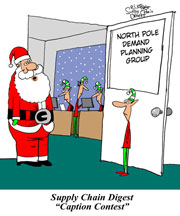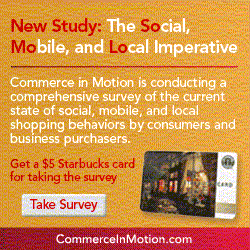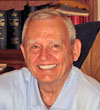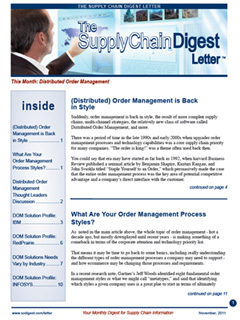 |
December 15, 2011 - Supply Chain Newsletter |
 |
This Week In SCDigest
FEATURED SPONSOR: RedPrairie |
New Study: The SoMoLo Imperative |

No Supply Chain Blah, Blah, Blah 2011Seven years ago, I wrote our initial (and somewhat infamous) First Thoughts piece on "Let's Stop the Blah, Blah, Blah." The basic theme: too many presentations at various conferences and other events don't say enough of real value. The jab was aimed primarily at speakers from the consulting, academic, solution vendor, author, and sometimes even the analyst community. This group, as we've noted before, too often tends to be focused on sound bites and restating the obvious, rather than delivering real insight. As always, I include myself in the category of those speakers who risk blah, blah, blah-ness at times, and recognize how hard it is, especially if you speak frequently on different topics, to avoid it now and then. I fully admit to falling into blah, blah, blah territory occasionally. All that said, I offer again our Audience Bill of Rights, which offers some reasonable guidelines for what you should expect and demand from presenters. We have even heard of conferences where organizers are now using this document in communicating with speakers. I actually went to a bit fewer events this year than usual. That was primarily caused by several major conflicts, with an unusual number of events overlapping. Anyways, I attended at minimum NRF, WERC, CSCMP, SAPICS (South African APICS), ISM, ProMat, the eyeforetrasnport Supply Chain Executive Summit, the MIT Supply Chain Forum, the JDA Software User Conference, the JDA Demand Council meeting, the High Jump Software User Conference, the Oracle TMS User Conference/SIG, and a couple of private company supply chain meetings. That's 11 regular conferences by my count - I am north of 15 most years. I better recover in 2012. I saw a number of very good presentations, but I cannot say that any of them really inspired me or were characterized by a compelling new vision in the way many of our Presentations of the Year have been in the past. I am sure they were out there, I just didn't happen to catch one this year.
So, here are my picks for our supply chain presentations of the year. All individuals were obviously at the named companies at the time of each presentation. Could be some changes in the meantime, though we don't know of any. Listed in random order, except for the last two. PepsiCo's Animesh Ukidwe, for a presentation at the JDA User Conference on what I called "wave management for TMS." This was a new front end Pepsi built for its existing TMS implementation that automated the process of getting its massive order pool (across business units) into optimization runs, and then smartly deciding which loads should be promoted to execution and which thrown back into the hopper for a next run. Very competent and interesting presentation, but wins for the sheer innovation of the idea - will be the way all large shippers do it someday. Goodrich's Susan Modeland, at the ISM annual conference, on the company's approach to supply chain risk management. She is an energetic presenter, and convincingly made the argument that few companies really did a thorough job of vetting risk consistently. She also detailed two tools Goodrich has developed - a risk dashboard and a risk "register" that tracks emerging risks across the globe - that should be models for hundreds of companies to emulate. Bill Lindeke of Kimberly Clark, assisted by Mike Marlowe of Kane is Able, who at the WERC conference described how KCC is "co-locating" its co-packers within its distribution centers. This is just an innovative idea, and Lindeke did a great job of explaining the challenges, benefits, and lessons learned. Former DHL executive and now parcel consultant Jerry Hempstead, who in an SCDigest Town Hall Meeting in early 2011 counseled parcel shippers on how to best manage significant rate hikes by both UPS and FedEx. You want the absolute real deal - this was it, from someone who knows. Blew me away. The good news: we're repeating the effort again for this year's hikes in mid-January. Details next week. Walmart's Greg Forbis, senior director of inbound transportation, at CSCMP, where he gave a great update on Walmart's controversial program to take control of inbound vendor freight. Why is this in the list? Because Walmart presentations tend to be very high level and mostly brag about Walmart. This did a little bragging at the beginning, but then was real, honest, and surprisingly detailed about where Walmart had gone right and wrong in the program's inception and execution. More please. Professor Nick Binedell of South Africa's Gordon Institute of Business Science, who gave an excellent and very entertaining presentation at SAPICS that did as good a job as I have seen in summarizing an impressive amount of detail about business and demographic trends across the globe. Let's just say there is a lot to know. I don't know if he invented the concept, but I liked his "3 C's" of pressures facing companies today: Change (increasing at a more rapid pace), Complexity (likewise growing rapidly) and Competition (growing and global). Fairchild Semiconductor's supply chain chief Kevin Chynoweth, who gave a great presentation at the JDA conference on how to think about managing a supply chain in periods of demand constraints versus supply constraints, but what really struck me were the changes Fairchild has made to connect "top floor to shop floor." Unlike a few years ago, there is simply absolute alignment there now between S&OP forecasts and other high level plans and what happens in the downstream fabs and assembly operations, to the point where customer priorities and service policy segmentations at higher levels of the company's planning are exactly reflected in Fairchild's detailed manufacturing planning. Excellent. Brad Fisher of Sears, who at the Oracle TMS Users Group detailed how the retailer has built a powerful TMS dashboard that serves not only the transportation department, but many others in the company as well. This has to be among the most comprehensive TMS analytics applications on the planet, and this was a truly classic "how to" presentation that was both detailed and easily comprehensible. The project was a lot of effort over several years - but the results are game changing. Brian Spearman of PepsiCo, who at the MIT supply chain forum gave a very interesting and detailed presentation on Pepsi's s journey with automated case picking (ACP) at its bottling operations - a subject of big interest to us here. The core message of which is that ACP works, but just how far you go has to be tailored to the specific volumes, footprint, and other factors of each warehouse. No one size fits all. By the way, first time ever two speakers from the same company in our list. Presentation of the year runner-up: Eric Robinson of Lowes, assisted Mark Garland of Capgemini, who at the JDA User Conference gave a "tour de force" presentation on how Lowes is implementing a new set of demand planning and replenishment software. Robinson explained how Lowes has "over invested" in its upfront conceptualization phase, from wide ranging interviews with users and execs to development of a full prototype system for analyzing the fit with business needs before deployment. This was in fact motivational - this is the way to do software implementation right, as we all know but usually don't do. And our Supply Chain Presentation of the Year goes to Rudi van Schoor of SABMiller's South African operations, who detailed the brewer's initial real and serious problems with implementation of a new advanced planning system - and how ultimately these were overcome by taking a step back, recasting the mission, and simplifying the deployment. This again was the "real deal" - companies rarely present where they went wrong - and it was a story that you were very interested to learn what was going to come out in the end. Very nice job. Not one minute of blah, blah, blah here, and I mean it. Just FYI, previous SCDigest Best Presentation of the Year award winners were: • 2010: Chris Gaffney of Coca-Cola, how to bring balance into increasingly challenging supply chain careers, and how with the right formula less can really be more for both managers and the company
Did you see any outstanding presentations, especially any that were highly visionary or motivational? In general, are you happy with the quality of presentations you see at conferences? What can vendors and consultants do to make their presentations better? Let us know your thoughts at the Feedback button below.
|
|
||||||||||||||||||||||||||||||||||
New On Demand Videocast:
|
New On Demand Videocast:
|
New SCDigest Letter on Distributed Order Management Subscribe Now to Ensure You Receive a Mailed Hard Copy Mailing in a Few Days
|
We received a number of good letters on our First Thoughts piece on The 10 Dimensions of Supply Chain Excellence. That includes our Feedback of the Week from Jenny Kukoleva of United Stationers, who thinks there is a simpler approach.
Find her letter and other good ones below.
Feedback of the Week: On 10 Dimensions of Supply Chain Excellence:
There are actually a couple of systematic ways of assessing a supply chain that are well accepted and taught under the theory of the Supply Chain Management. They are Balanced Scorecard and the SCOR metrics. For example, the SCOR model uses the following metrics to assess and benchmark a supply chain: 1. Supply Chain Reliability - measured by Perfect Order Fulfillment rate; 2. Supply Chain Responsiveness - measured by Order Fulfillment Cycle time; 3. Supply Chain Flexibility - measured by # days required for the supply chain to achieve an unplanned sustainable X% increase/decrease in volumes delivered; 4. Supply Chain Costs - measured by the SCM costs as % of COGS; 5. Supply Chain Asset Mgmt - measured by Cash-to-Cash cycle time and Return on Supply Chain fixed assets) Would the above not work to evaluate one's supply chain excellence? I am not disagreeing with the 10 dimensions list in the article and definitely agree that SC structure needs to be aligned with the overall business strategy, but I think that the above metrics are a lot more measurable and actionable.
Jenny Kukoleva
|
||
More on 10 Dimensions:
|
||
Good article and I generally agree with the 10 dimensions you have listed with some nuances and comments.
10. Supply chain culture. This is the 800 pound gorilla in the room. Culture is largely invisible and extends across the entire organization, not just the supply chain. It is the hidden environment that defines how the organization works and how to stay out of trouble. Yes, culture can be set from the top, but do not underestimate how hard it is to change when an established culture is in place. As you work to develop a maturity model, you might want to take a look at some old references that may help with a framework. Two that come to mind are Logistical Excellence by Don Bowersox and others, 1992 and World Class Logistics, CLM, 1995. David Armstrong, Principal
|
||
| I enjoyed reading your article about the top 10 dimensions of Supply Chain Excellence. It is a worthy topic of discussion. You are right about Customer Satisfaction probably needing to be at the top of the list, just not on the list of dimensions. It is not a dimension, it is a measure, as you actually state in the article. You improve customer satisfaction and supply chain performance by implementing the other 9 dimensions. You can't action customer satisfaction in and of itself.
Paul Clark
|
||
| Your list of dimensions in supply chain excellence is great. I think you've captured all the high points especially the talent management. Those companies that undervalue that aspect usually aren't top performers.
As I have done many times in the past, I will cite your observations in my MBA class on Strategic SCM. Jack Ampuja
|
||
SUPPLY CHAIN TRIVIA ANSWER
Q: What NFL kicker has an undergraduate degree in logistics management? (hint: he attended a well-known program)?
A: Mike Nugent of the Cincinnati Bengals, who went to Ohio State.
| © SupplyChainDigest™ 2003-2011. All Rights Reserved. SupplyChainDigest PO Box 714 Springboro, Ohio 45066 |
POWERED BY: XDIMENSION |









